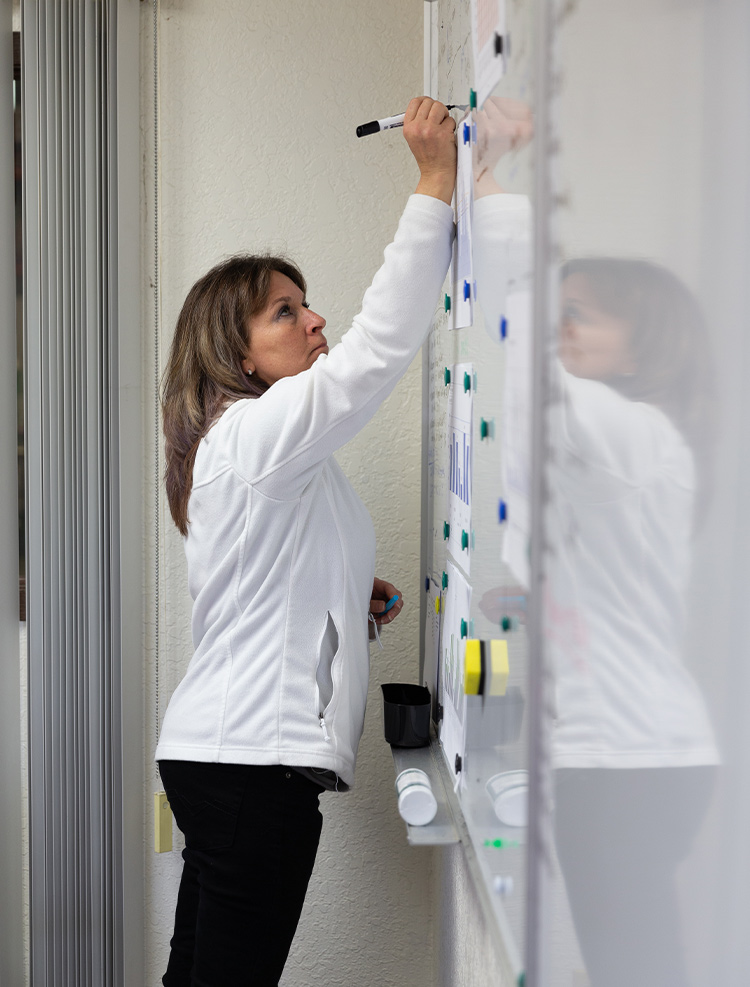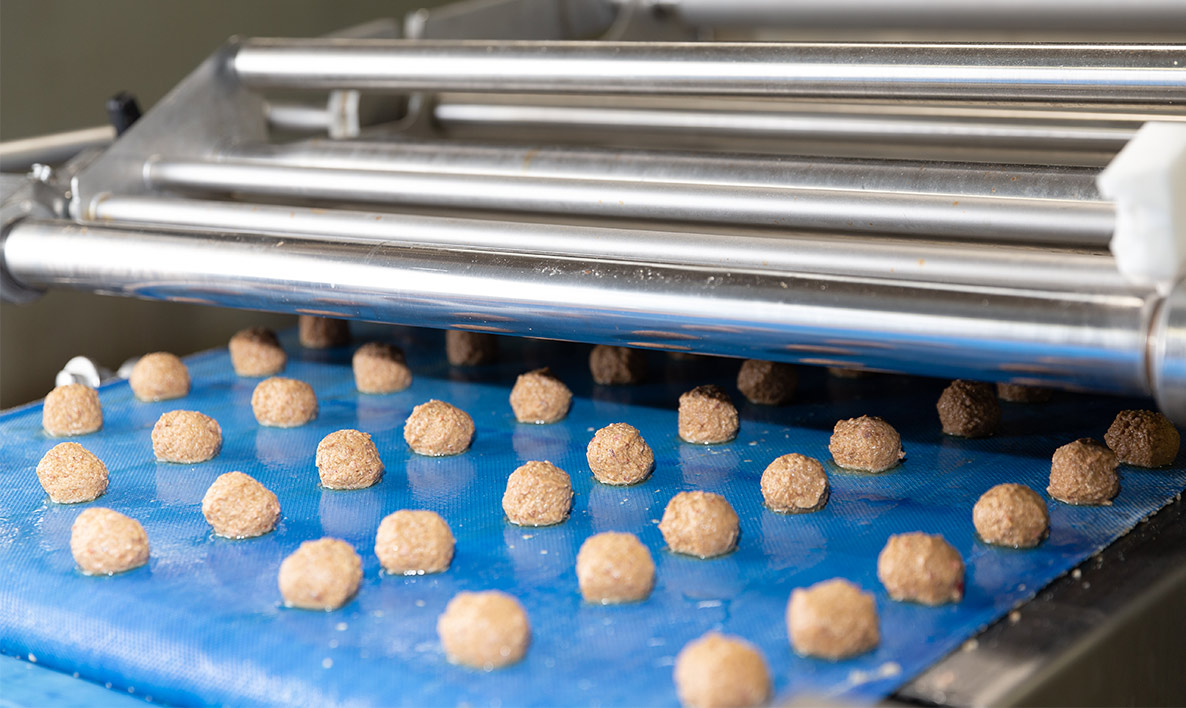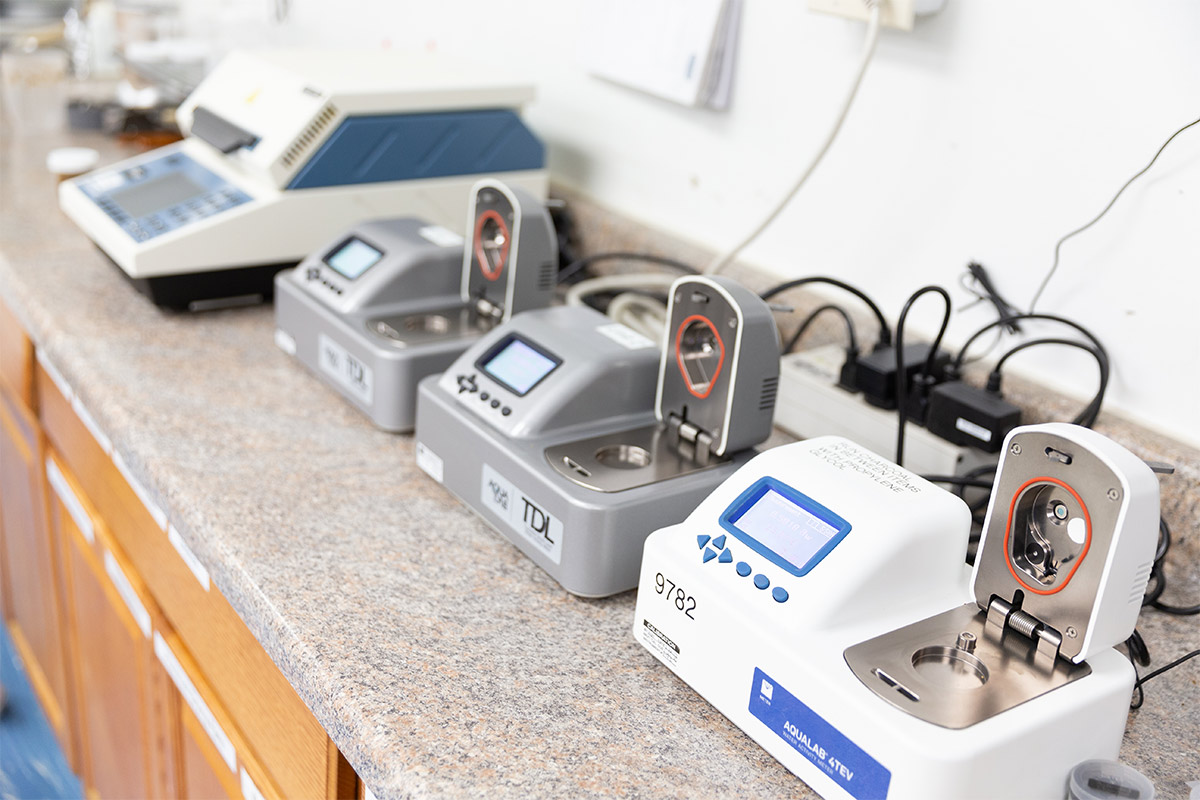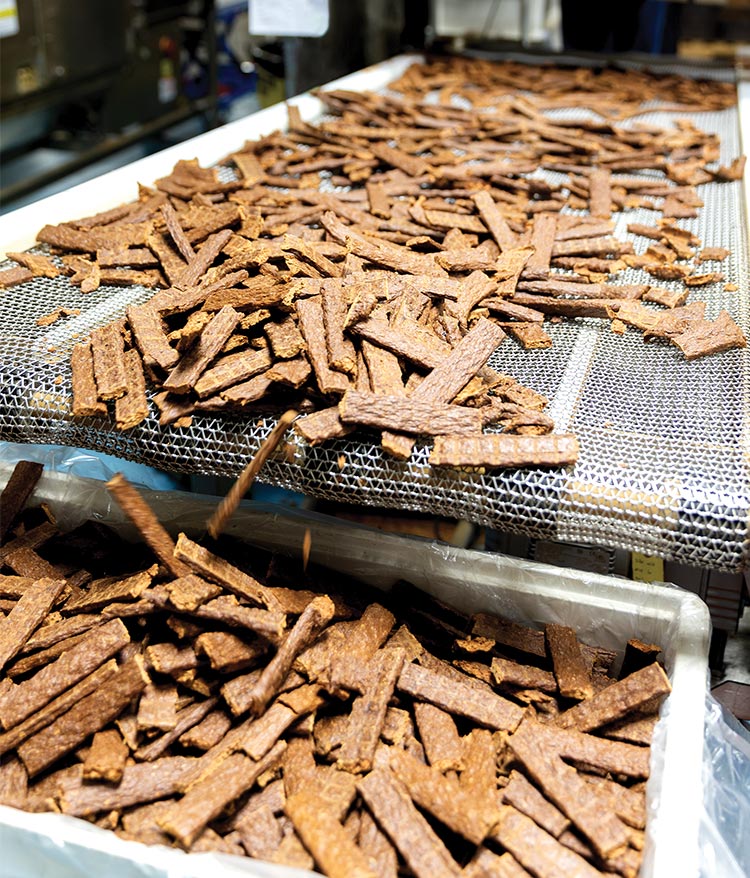This article was published in the June 2019 issue of Pet Food Processing. Read it and other articles from this issue in our June digital edition.
|
|
This article was published in the June 2019 issue of Pet Food Processing. Read it and other articles from this issue in our June digital edition.
Although Phelps Pet Products has a 52-year history of producing meat-based pet treats, almost everything about the company is new including its name. A rebranding from Phelps Industries to Phelps Pet Products in March was the culmination of an intense focus on growth that began in 2014. Company founder Dick Phelps sold a majority stake in January 2013 to the private equity group that is now known as Granite Bridge Partners. The next year under its new leadership, the company expanded its Rockford, Illinois production space with the addition of an 80,000-sq.-ft. building next door to the company’s original 10,000-sq.-ft. facility. And then in 2016 the company added 40,000 sq. ft. of warehouse and distribution space with a third location in Caledonia, Illinois.
Phelps manufactures specialty pet treats, jerky sticks, strips and tenders sold under private label and contract manufacturing agreements to leading retailers and pet food brands in North America, the European Union and Australia.
“Anybody who is in the better-for-you space, like Sprouts and Newman’s Own, that’s what we’re really good at,” says Rick Ruffolo, CEO and president. “We are USDA certified organic as well as Safe Quality Food Level II (SQF) and Marine Stewardship Council (MSC) certified. We produce conventional products also, but the certifications are one of the key areas that separate us.”
“We’re OK with identifying internal issues. That’s how we prevent them from becoming external issues,” Ruffolo says.
Another is the company’s focus on performance metrics. Pet Food Processing was invited to join Phelps’ daily stand-up meeting and witness the metrics the management team and key leaders review on a daily basis to gauge the company’s progress toward its target goals. Numbers, customer names and discussion topics are written on the dry-erase boards lining the perimeter of a conference room along with print-outs of colorful graphs. This wall of information is updated daily with a broad range of metrics offering a snapshot of the company’s performance. The group reviews quality alerts from the day before, daily SQF training topics, start times of each processing line for each shift, last batch time, number or racks per shift per line, production output in pounds, changeover efficiency by customer name for the previous day and what is planned for today, total dollar value of shipped product per day, per line and per shift as well as the current monthly sales total and maintenance items for the day… just to name a few.
The metric method
For Phelps, this daily performance review becomes both strategic and tactical. The metrics are not confined to a conference room or a computer file. Metrics are shared with employees during monthly all-staff meetings and each production line in the plant has a communication board that identifies the goals for each shift. “The boards on the lines include hour by hour charts, so line workers know if they are on pace and if they’re not, they’ll record the cause and our line leaders actively escalate items to ensure we are quickly resolving issues,” says Scott Anderson, director of operations.
Quality alerts are used to document the unexpected. “They give us an historical record of anything that goes not to plan,” says Rich Bartuska, director of safety, quality and regulatory. “We act upon the alerts and our system notifies all of the management team that this event occurred. That’s key to continual improvement. We correct the problems and look at them historically to identify any trends and eliminate those from happening in the future.”
The core management team is relatively new for a 52-year-old company with the longest tenured person having just five years with the company. “We were brought in a couple years ago to start making the business scalable,” Anderson says. “The first place we started was to ask: Are we measuring the right things? Are we tracking the correct data so we can be a data-based, decision making organization?”
If a processing line had a low number of racks during a shift the previous day, the reason is identified, whether it was due to training during that shift or a delayed delivery of meat. During the daily stand-up meeting, the reason is discussed and, where applicable, a remedy is quickly agreed upon. Then it is on to the next metric. Closely watching line efficiency trends becomes a valuable tool for preventive maintenance as well.
It’s clear that the company has a laser focus on overall equipment effectiveness (OEE) which translates to overall company effectiveness. “What I like about all that we track is that it’s the facts — not an interpretation,” Ruffolo says. “It’s a snapshot of where we stand at this moment and if we’re heading in the right direction. We’re OK with identifying internal issues. That’s how we prevent them from becoming external issues.”
Patience pays off
Between 2014 and 2016, the company’s production space grew from 10,000 sq. ft. to 130,000 sq. ft. They first added packaging lines and eventually added a second processing line and additional ovens, then more freezer storage and warehouse space. The sales growth, however, didn’t kick into gear until the end of 2018. According to Ruffolo, sales from 2017 to 2018 were more or less flat. “We had a good end to 2018 and we are in high growth mode right now.” Sales are up 37% for the first quarter of 2019 compared to the same period in 2018.
Ruffolo attributes this growth to the investments the company made in people, processes and equipment. “In the last two to three years, we’ve gained the ability and the certifications to produce the more value-added, clean label, limited ingredient, certified organic treats that are now our primary business,” Ruffolo says. “In the past, it wasn’t really part of what the company did partly because the market wasn’t asking for it — 50 years ago organic wasn’t on anybody’s radar.” Transitioning to offer USDA certified organic products, formulating cleaner ingredient panels and streamlining processing required investment spending before the company could pursue sales growth. “During this time, we were not chasing every opportunity because that growth would have been old growth with our old processes,” Ruffolo explains. “We wanted new growth in the product areas that we are now targeting.”
“Anybody who is in the better-for-you space, like Sprouts and Newman’s Own, that’s what we’re really good at,” Ruffolo says.
Private equity groups often acquire a business, target investments in that company to produce quick growth and get out in a year or two. Granite Bridge Partners has been patient, Ruffolo says. “It takes work to be on the leading edge of the humanization trend providing our customers with a wider variety of meat and protein choices. Across the board we restaged all the formulations and the processing parameters. It required starting over in many instances and took a lot of hard work.”
After Granite Bridge Partners put the current management team in place, the workforce of more than 100 employees transitioned from largely temporary to mostly fulltime permanent positions. “Transitioning from a primarily temporary workforce environment to fulltime was a huge step forward for us from a quality and execution standpoint because we now have trained people who work well together and know what is expected of them,” Ruffolo says. “I’m a big believer in people being able to voice their opinion based on what they are seeing, or their point of view based on the data they have. If you’re a temporary employee, you might not have the contextual understanding of what that moment means or anything to compare it to. We strive for an environment where we listen to each other and value each other’s insights.”
This focus on improvement has resulted in new thinking around OEE. The company’s processes have changed almost completely from start to finish.
Batch benefits
In the company’s main building — the largest of the three at 80,000 sq. ft. — the process starts with the incoming raw materials. Then 600- to 800-lb. batches are prepped to go into the ovens. Once the batch is cooled, it’s tested by the quality department before it’s cleared for cutting and packaging. The company’s original building next door contains a second, identical processing line and more ovens. From this building, batches are processed, cooked and tested, then brought to the main building for packaging.

Batches start with a frozen block of meat. The blocks are reduced to smaller frozen chunks with a Rotoclaw II from Reiser, Canton, Massachusetts. The smaller frozen pieces of meat go into a Seydelmann bowl cutter where the ingredients for the batch are ground and blended. Then the homogenous mixture is transferred to the hopper of a Vemag extruder that forms the mixture into whatever shape the batch requires. The Seydelmann bowl cutters and Vemag extruders are both from Reiser.
Formed product is manually arranged on trays. The trays go on racks and each rack is loaded into one of seven batch ovens from Alkar, Lodi, Wisconsin, for cooking and dehydrating. The ovens hold between nine and 15 racks. “We average a couple hundred pounds of cooked product per rack,” says Anderson. “Our average cook time is 9 hours so typically we get two turns of the ovens in a day, but it depends on the formula, the protein content and, most importantly, the shape itself.”
The trays used for organic products are segregated, as is production. Each day starts with the “cleanest” products because everything has been cleaned and sanitized the shift before. Products with ingredients considered to be allergens run at the end of every day.
During baking and prior to cooling, oven operators test the product for moisture and water activity. Once a batch is fully cooked and cooled, it must be tested again by the quality department.
Phelps recently upgraded its product testing devices to include a moisture analyzer from Arizona Instruments, Inc., Chandler, Arizona. Aqualab TDL instruments from Meter Group, Pullman, Washington, measure water activity in samples.

Samples from each batch are tested for quality. No product moves on to cutting and packaging that hasn’t been cleared by quality. “We spend a lot of time making sure that the product never gets to come over into the packaging side of the building until quality control says it can come over here,” Bartuska explains.
The next step is cutting the product to the specified length. This extra step is added for efficiency which might sound strange. Additional steps don’t usually equate to increased efficiency but for Phelps, oven efficiency is the priority. Products cook in the ovens between four and 28 hours depending on the product and, by not cutting product to its finished size and dehydrating uniformed lengths instead, the company maximizes the amount of product on each tray and achieves more overall output from the ovens. Phelps has three cutters, two from Urschel, Chesterton, Indiana, and one from Eaglestone, St. Charles, Illinois.
After product is cut to size it moves on to packaging. Phelps currently has four packaging lines: two form-fill-seal systems from Heat and Control, Hayward, California; one Roberts IMP Series pre-made bag line from AlliedFlex Technologies, Sarasota, Florida; and a new high-speed form-fill-seal packaging line from Mamata, Montgomery, Illinois.
Product comes into the packaging area in tubs and is manually spread out on conveyer belts. This step ensures proper product spacing and allows for one final visual quality check before bucket conveyers bring the products up to Ishida multihead weighers for portioning. Finished packages are passed through metal detectors and checkweighers as well as visual inspections before they are approved to ship.
Phelps works directly with packaging supplier Belmark, De Pere, Wisconsin, for most of the roll stock packaging it uses. Because of Belmark’s close proximity, Phelps does not have to store a large amount of packaging materials and operates on a primarily just-in-time basis with Belmark.

The Mamata packaging line was purchased to increase overall production capacity. OEE plays a large role in the company’s decisions to add more equipment. “We literally count all available time as potential output time, so breaks hurt our OEE, but breaks are part of the day so we count them,” Ruffolo says. “We’ll never reach 100% but that percentage is not our grade. Our grade is more about whether our percentage is higher today than it was yesterday. It’s the trend direction that is most important.”
Ruffolo adds that the new high speed Mamata packaging line was a huge step forward for Phelps in terms of output, capacity and flexibility. The equipment side now supports higher output and growth. Something as simple as purchasing additional racks, trays and bins has also helped by improving the flow of product and helping production stay ahead of packaging.
Phelps works with its customers to forecast their production needs, which helps Phelps find line time to meet customer expectations and maintain OEE. Phelps’ product development engineer, Bryant Williams, uses a small Hobart mixer to create micro test batches for prototypes. These small, 10- to 15-lb. test runs help validate new products and do not disrupt production.
When asked what the next investment might be to increase capacity, Ruffolo said it could be more ovens or another processing room but before that would happen, more racks, more trays and more hours of people working will allow the company to grow. “Currently, we are not fully utilized. We’re focusing on OEE. The key investments we’ve already made are allowing us to grow in double digits but what investments we need to make in the future to sustain our targeted growth is a conversation we have every day,” Ruffolo says.
At Phelps, growth encompasses much more than increasing production and reaching a sales metric. “It’s growing with new customers, growing with our current customers, growing in our understanding of the market and new ways to go to market,” Ruffolo explains. “Every new conversation we’re having with customers, we’re starting to get to know what they’re trying to do and how we can help them with that. We are building momentum here. People like to be on a winning team, and we are starting to feel like a winning team and that’s exciting.”



